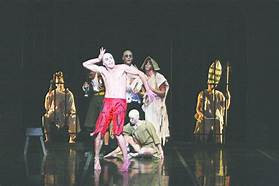The Rakes Progress Ballet is a short ballet done in six scenes. It was first performed by Vic-Wells Ballet at the Sadler’s Wells Theatre on the 20th of May 1935.
The Choreography for The Rakes Progress was done by Ninette de Valois and the scenery and costumes by Rex Whistler after Hogarth. William Hogarth was the artist who did a series of drawings called The Rake’s Progress and the ballet was based on these drawings. The music was done by Gavin Gordon.
Gavin Gordon had written some earlier ballets that were not successful, but the Rake’s Progress was an instant hit and has remained in the repertoires of a number of ballet companies. It is the only work of Gavin Gordon’s that is remembered today.
The ballet was Gordon’s own concept, and he persuaded Ninette de Valois to choreograph it.
The original scenery and costumes were destroyed in the Netherlands during the Second World War, while Sadler’s Wells was visiting that country, but were remade for a revival.
In its blend of dance and mine, The Rake’s Progress Ballet continues where the ballet Job left off. Like Job, it is a wonderful piece of theatre craft, strongly native and not at all like the style of the Russian Ballet. It is an intensely English ballet in every element.
De Valois’ choreography reflected on the developing technical resources of her company and her decision once more was to challenge their dramatic ability.
The ballet has a lot of characterization and different moods, as well as two technically demanding male roles in the Dancing Master and The rake, created originally by Harold Turner and Walter Gore.
Through movements combining acting and classical dance steps, the minor girl’s solos, first dance by Alicia Markova, are never solos of technical display in the Petipa manner, but continue the story and develop her character. Being the only innocent and honest person in the ballet she is distinguished from her sordid surroundings by being the only woman to dance on pointe.
The Rake, too, is depicted choreographically with great economy. In the early scenes as a young nouveau riche, the basis of his choreography is classical, with legs turned out. Port de bras is exaggerated to show his gaucheness with the palms of the hands turned down and the elbows lifted to establish the eighteenth-century period. As his character deteriorates from brothel to gambling den to madhouse so he loses his classical movements becoming wild and uncontrolled like an animal.
The Rake’s Progress Ballet Storyline
 The ballet consists of the following scenes:
The ballet consists of the following scenes:
Prelude
The Reception
Having inherited a fortune, the Rake, in his new house, is surrounded by people anxious to enter his service and be his friend. He takes lessons in dancing, parts freely with money, and rejects the girl he has betrayed under the promise of marriage.
The Orgy
In gay, disreputable company, the Rake tastes the joys of wine, women, and song.
The Street
The Rake having squandered his inheritance is about to be arrested for debt when the betrayed girl pays his creditors with her savings.
A Gaming House
The Rake attempts to retrieve his position at the gaming table only to lose it all.
Near The Prison Gates
The Rake is committed to a debtors’ prison, but the girl waits patiently for his release.
The Madhouse
The Rake, ruined in body and mind, dies in a madhouse.
Other famous artists associated with Rake’s Progress Ballet include Margot Fonteyn and Beryl Grey.
This is an extract from the beginning of the Rakes Progress Ballet.

